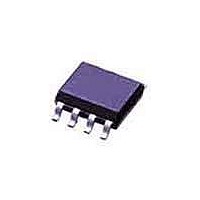1203S08-U THAT Corporation, 1203S08-U Datasheet - Page 7

1203S08-U
Manufacturer Part Number
1203S08-U
Description
Difference Amplifiers High-CMRR Bal Input Line Rec. -3dB SO-8
Manufacturer
THAT Corporation
Datasheet
1.1206S08-U.pdf
(12 pages)
Specifications of 1203S08-U
Maximum Operating Temperature
+ 85 C
Minimum Operating Temperature
0 C
Mounting Style
SMD/SMT
Operating Temperature Range
0 C to + 85 C
Output Current
+/- 25 mA
Operating Supply Voltage
+/- 18 V
Package / Case
SOIC-8
Lead Free Status / RoHS Status
Lead free / RoHS Compliant
600033 Rev 00
high frequencies, the junction of R
driven through C
mon-mode input voltage. Hence at high frequencies,
no common-mode current flows in resistors R
R
impedances, this effectively raises the input imped-
ance seen at In+ and In- to high-frequency com-
mon-mode signals. Of course, for differential signals,
the input impedance is (R
the common-mode input impedance is:
and either R
ICs, the input impedances Z
scribed by the following equations:
put frequency,
and OA
common-mode gain loop (OA
must have precisely unity gain over the entire audio
band. THAT Corporation integrated the InGenius
parts in our complimentary dielectric isolation pro-
cess because it offers very high bandwidth and low
Preprint 3917, October 1994
Bill Whitlock, AES 101st Convention Preprint 4372, 1996.
Noise), by Jim Brown & Bill Whitlock, AES 114th Convention, Preprint 5747, February 2003
7
For additional information refer to:
Balanced Lines in Audio Systems - Fact, Fiction, and Transformers, by Bill Whitlock, AES 97th Convention,
A New Balanced Audio Input Circuit for Maximum Common-mode Rejection in Real-world Environments, by
Common-Mode to Differential-Mode Conversion in Shielded Twisted-pair Cables (Shield-Current-Induced
, or R
Similarly to the single-ended application above, at
Z
For the resistor values chosen for the 1200-series
Z
Z
Z
In order to get the most out of this topology, OA
DC bias for OA
CM DC
CM DC
CM
diff
2
( )
8
=
f
and R
must have high input impedance, and the
R
=
= 36 Ω
=
7
6
(
36
R
R
+
or R
6
6
R
9
k
k
+
. Since OA
+
7
Ω
b
R
R
8
+
to the same potential as the com-
.
THAT Corporation; 45 Sumner Street; Milford, Massachusetts 01757-1656; USA
7
7
1
R
1 50240
)(
+
1 73 8
+
and OA
8
(
+
R
R
Tel: +1 508 478 9200; Fax: +1 508 478 0990; Web: www.thatcorp.com
(
+
8
8
R
+
.
+
6
9
+R
R
⋅
R
1
C
⋅
=
C
9
b
2
and OA
9
1
b
)
⋅
48 Ω
, OA
7
is supplied through R
f
⋅
+
CM
+R
f
)
2
)
R
k
2
5.
2
8
and Z
; where f is the in-
, R
+R
7
2
, R
have high input
10
9
). And, at DC,
/R
8
diff
, and R
11
, are de-
and OA
6
5
and
is
4
5
1
)
noise for relatively high-voltage applications like this
one. This in turn makes it easier to meet these re-
quirements, and typically, results in a maximum
mid-audio-band Z
plifier (OA
pedances, the CMRR of OA
resistors is determined solely by OA
and the precision of the resistor matching. Our com-
plimentary DI process contributes to high bandwidth
in OA
extremely good matching, as well as precise gain, in
those four thin-film resistors.
nals that a good differential line receiver must reject
is the power-line frequency: usually either 50 or
60 Hz and its harmonics. So, it is essential that the
common-mode input impedance remain high down
to 50 Hz, and up to at least to the edge of the audio
band. While THAT's process and circuit design en-
sure the latter condition, the value of C
mine how low in frequency the common-mode input
impedance will be increased. To maintain at least a
1 MΩ common-mode input impedance, C
at least 10 µf.
terms of the desired Z
However, reaching a general closed-form solution is
difficult and results in a very complex formula. The
relatively simple formula below takes advantage of
some approximation, and yields good results for Z
between about 100 kΩ and 10 MΩ.
Because OA
Finally, perhaps the most common interfering sig-
It is possible to solve the above equation for C
C
b
3
, and we use on-chip laser trimming to ensure
≅
0 553 10
.
3
) from the effects of external source im-
×
1
and OA
inCM
−
3
Z
CM
f
of > 20 MΩ.
CM
2
isolate the differential am-
3
for a specific frequency.
and its associated four
3
's bandwidth
b
b
will deter-
should be
Page 7
b
CM
in














